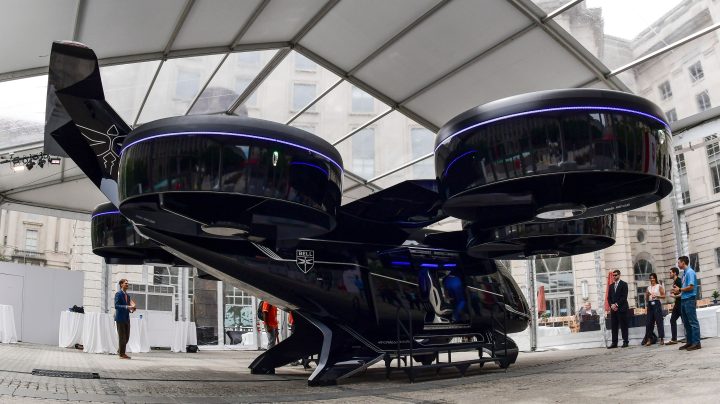
Flying taxis are promised soon. But how will they actually work?
Flying taxis are promised soon. But how will they actually work?

Later in 2020 (if you believe the optimistic deadlines of tech firms), some big-name companies are going to start test flights of air taxis. These machines will look like the small, buzzing, quadcopters, but scaled up to carry people over the traffic below.
A lot will need to happen, from aircraft to infrastructure, to make what’s being called a new era of flight safe and affordable.
Some companies are already demonstrating this “Jetsons”-esque vision of the future. So I went along for a ride over Los Angeles.
I have to confess a personal interest here. As an LA resident, I’m highly sensitive to travel times in traffic. For example, if I have to drive the seven miles from my house to nearby Dodger Stadium on a game night, my heart sinks. It can take 40 minutes or more.
Kyle Owens, with Otis Elevators, is determined to show me there’s a better way. “You can see in the app common travel times on road, and what flight times would be, so it helps you imagine a future of how you would fly,” he said, showing me his phone screen.

You may be wondering why an elevator company has a flying-taxi app. Otis Elevators is one of the many companies looking at the opportunity in the air — in its case getting people to the top of nearby tall buildings to catch a shared ride.
The app says the stadium is 3 minutes by air, so I say, “let’s do it!”
“Now the app will guide us from where we are currently standing over to the elevator bank, and it’ll then bring us up to where the helipad would be,” Owens said.
Now another confession. Flying-taxis don’t actually exist yet. A number of big-name companies are working hard on them, from Bell Helicopter, to plane makers, to Boeing and Airbus. Uber, better known for enabling networks of shared cars on the ground, is vying to be the platform for shared rides in flying-taxis.
So to get a feel for the next stage of the journey, I’m going old school with a vertical take off and landing vehicle that does exist, a Sikorsky helicopter.

“What we’re looking for in the future is how that third dimension of mobility can help access society as congestion continues to grow on the ground,” said Jonathan Hartman, the disruptive technologies lead at Sikorsky. It’s another one of the major helicopter manufacturers working on this next generation of air transportation.
This trip over the LA traffic is fast, and the views are great, but helicopters are big, loud, expensive to run, and restricted as to where they can fly and land. So they’re never going to be a solution for everyone.
Once we were back on the ground, Hartman told me that the next generation of drone-like air transport machines will be electric, quieter, and cheaper to run. Engineers call the giant drones EVTOL (Electric Vertical Takeoff and Landing) machines. They still need a catchier title, and the headlines veer between flying taxi and flying car.
Whatever they’re called, experts say it’s crucial to introduce any new technology like this to cities in a fair way.
“We want to think through where infrastructure gets placed, how to support these mechanisms so that those communities that have been left behind, aren’t in the future,” said Harrison Wolf from the World Economic Forum. He focuses on aerospace and drones, and joined me on my flight. The risk is that flying machines become a way for the wealthy to avoid congestion on the ground, but don’t contribute to improved mobility for the majority of people in the way a mass transit project could.
All this may seem like fantasy, but the companies involved are determined to make flying taxis a reality, with demonstration flights planned in 2020, and commercial service up and running in Melbourne, Australia, Dallas, and my home, LA, by 2023. Which could make those game nights just a little less painful.
There’s a lot happening in the world. Through it all, Marketplace is here for you.
You rely on Marketplace to break down the world’s events and tell you how it affects you in a fact-based, approachable way. We rely on your financial support to keep making that possible.
Your donation today powers the independent journalism that you rely on. For just $5/month, you can help sustain Marketplace so we can keep reporting on the things that matter to you.


















